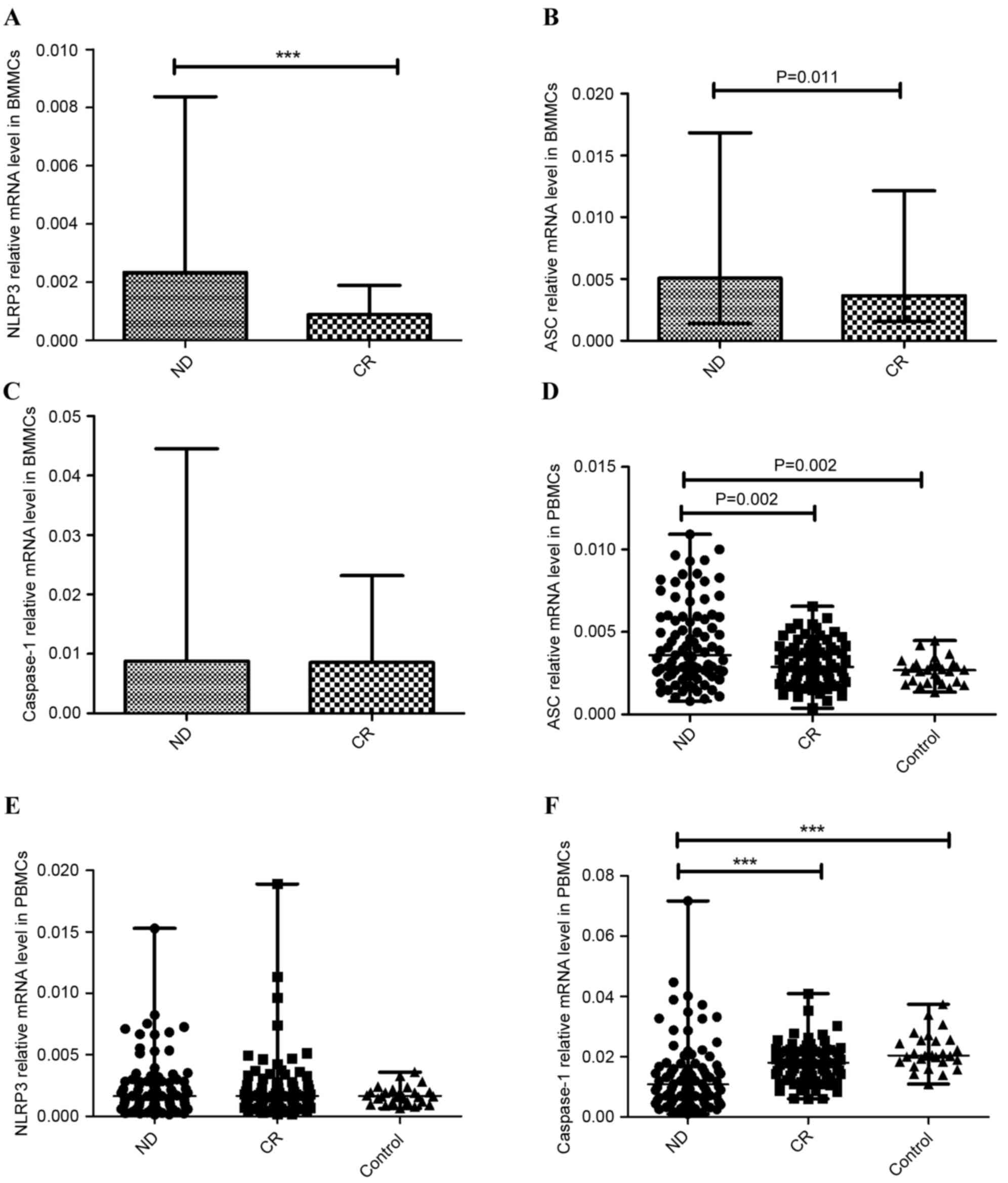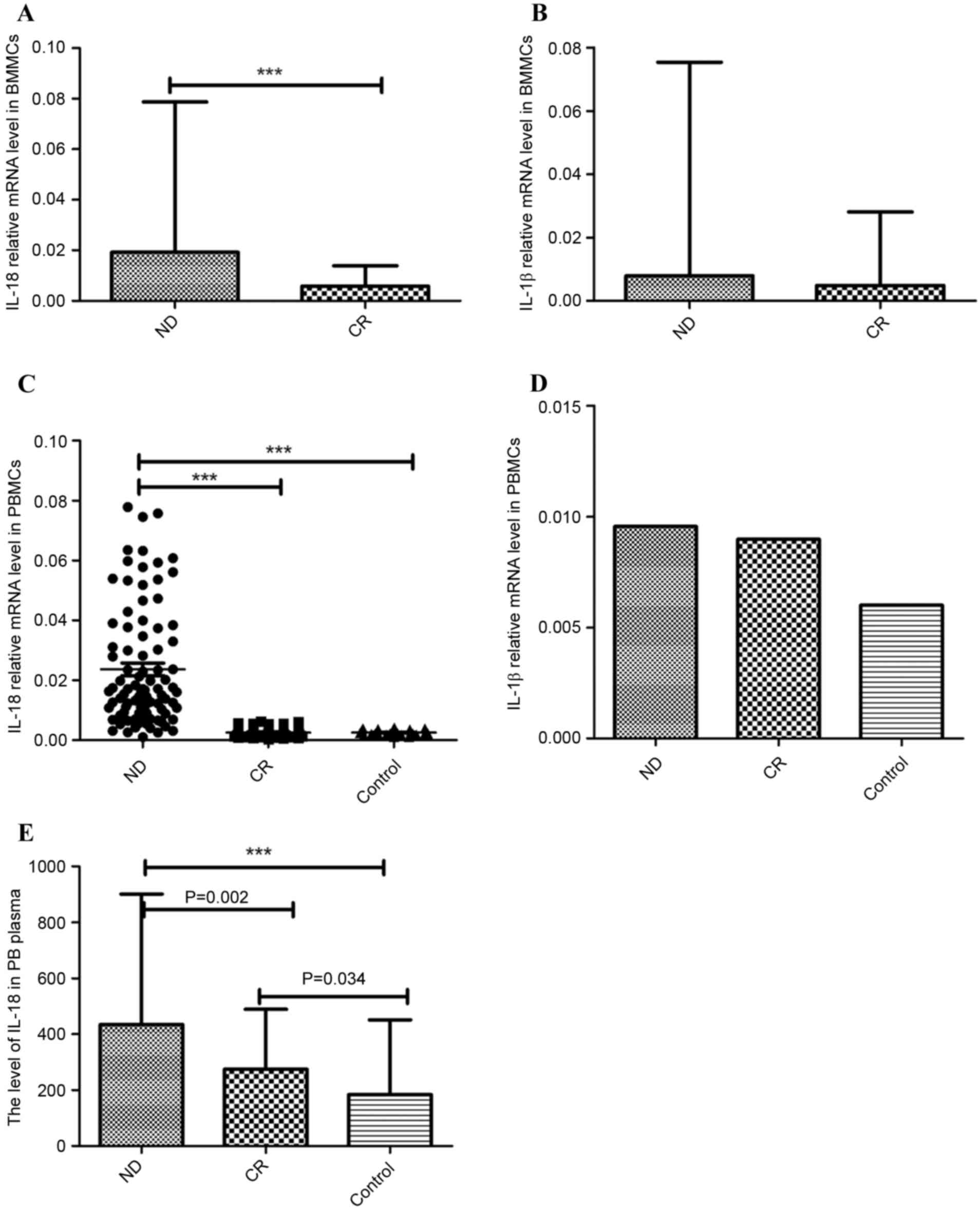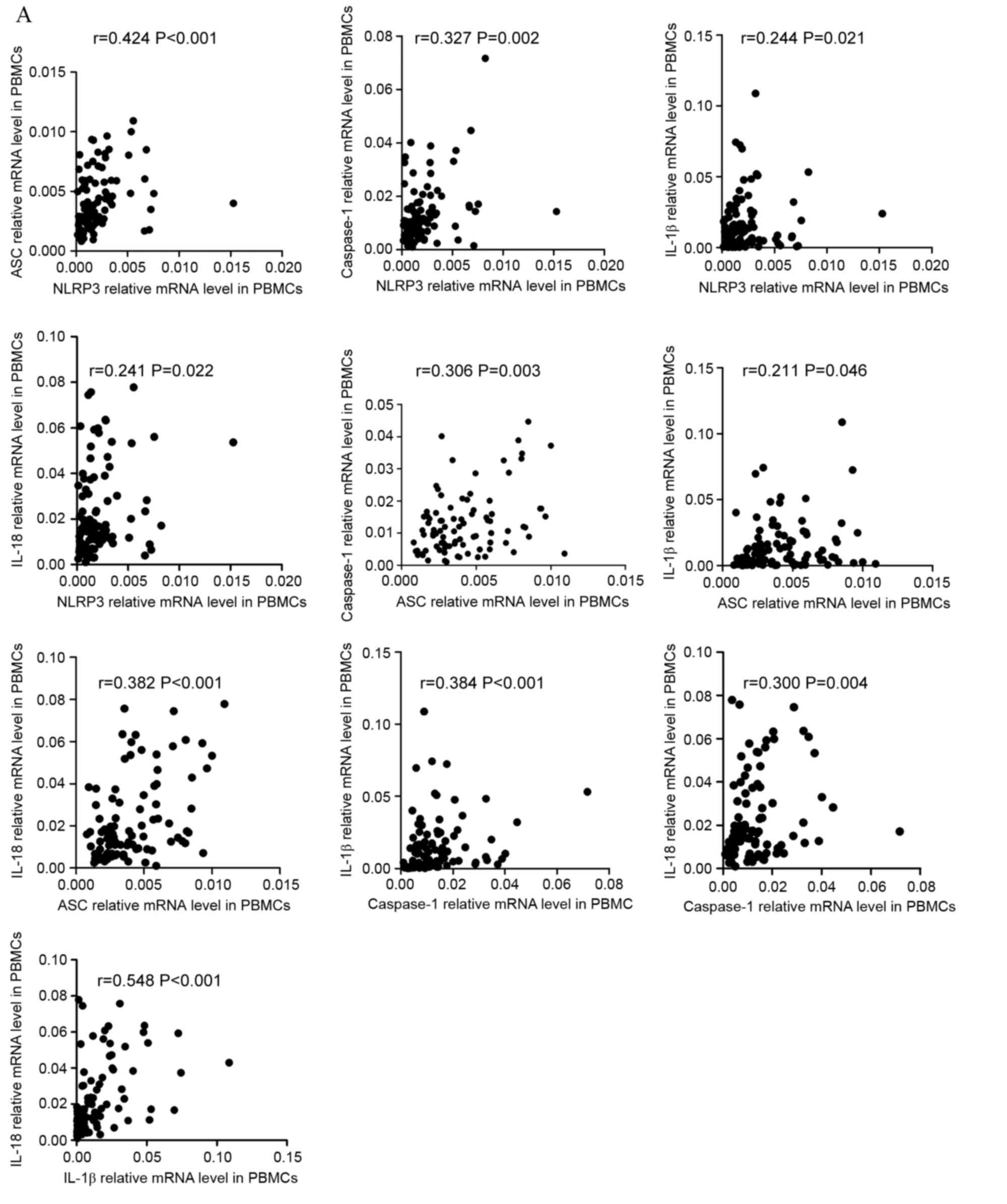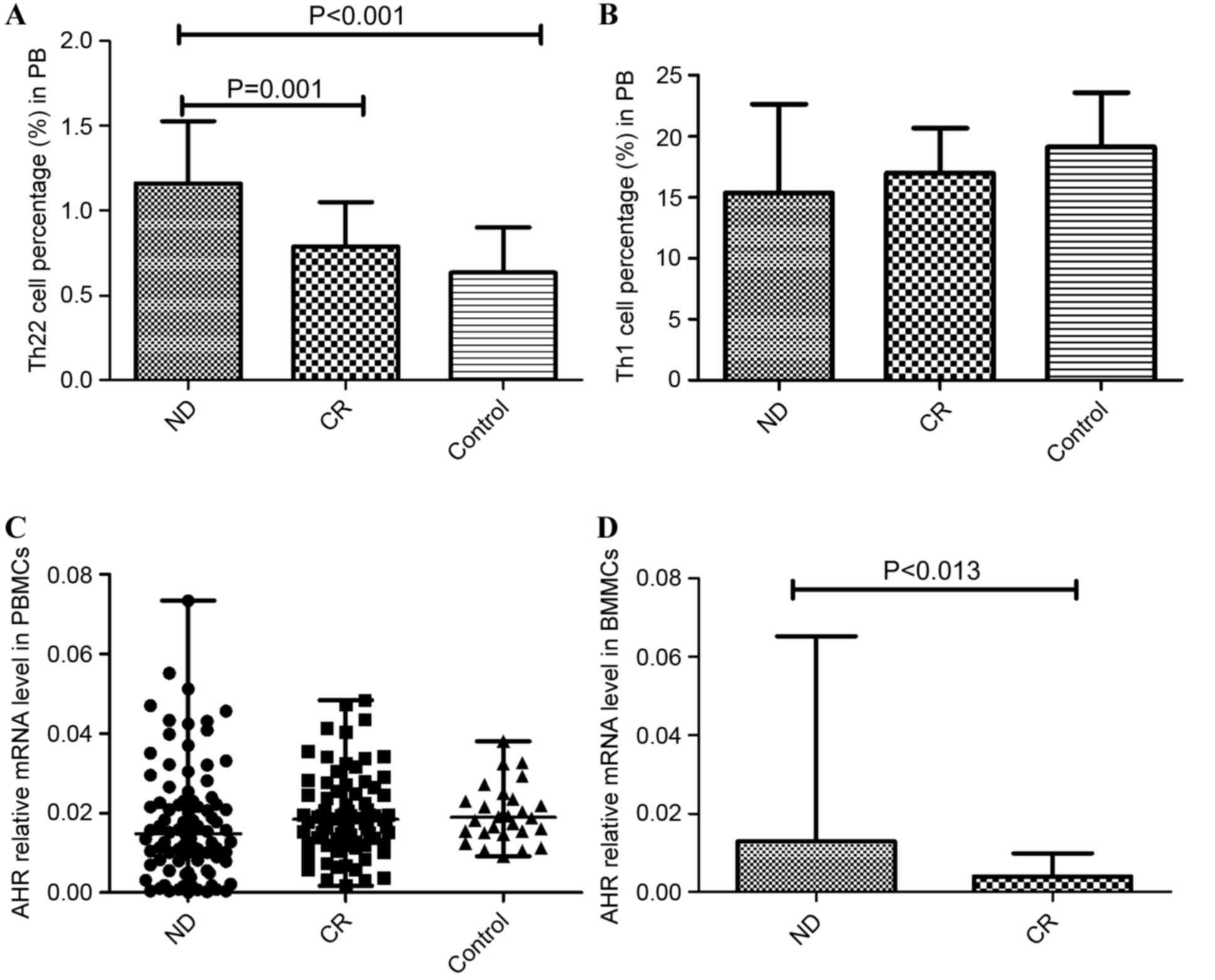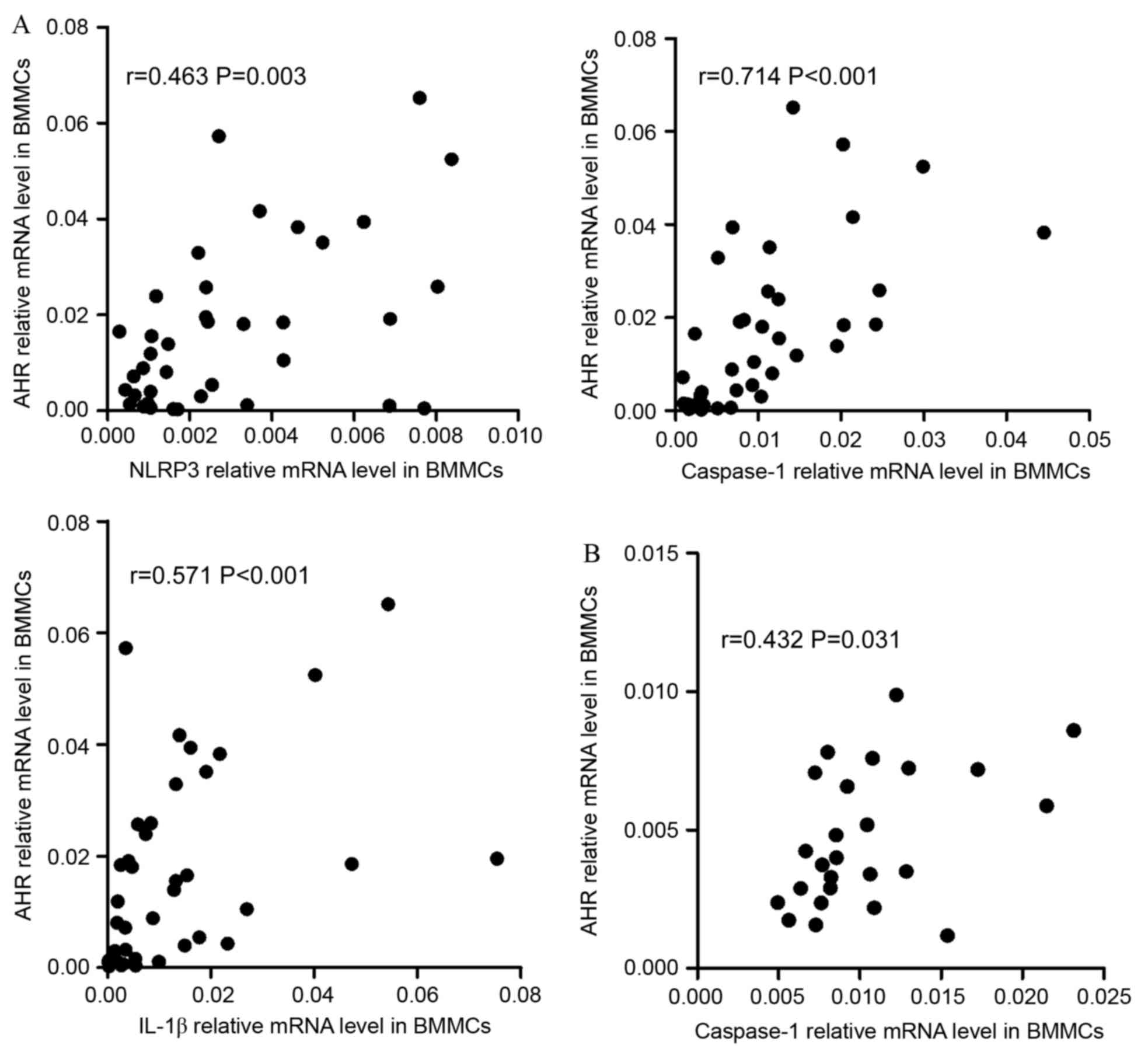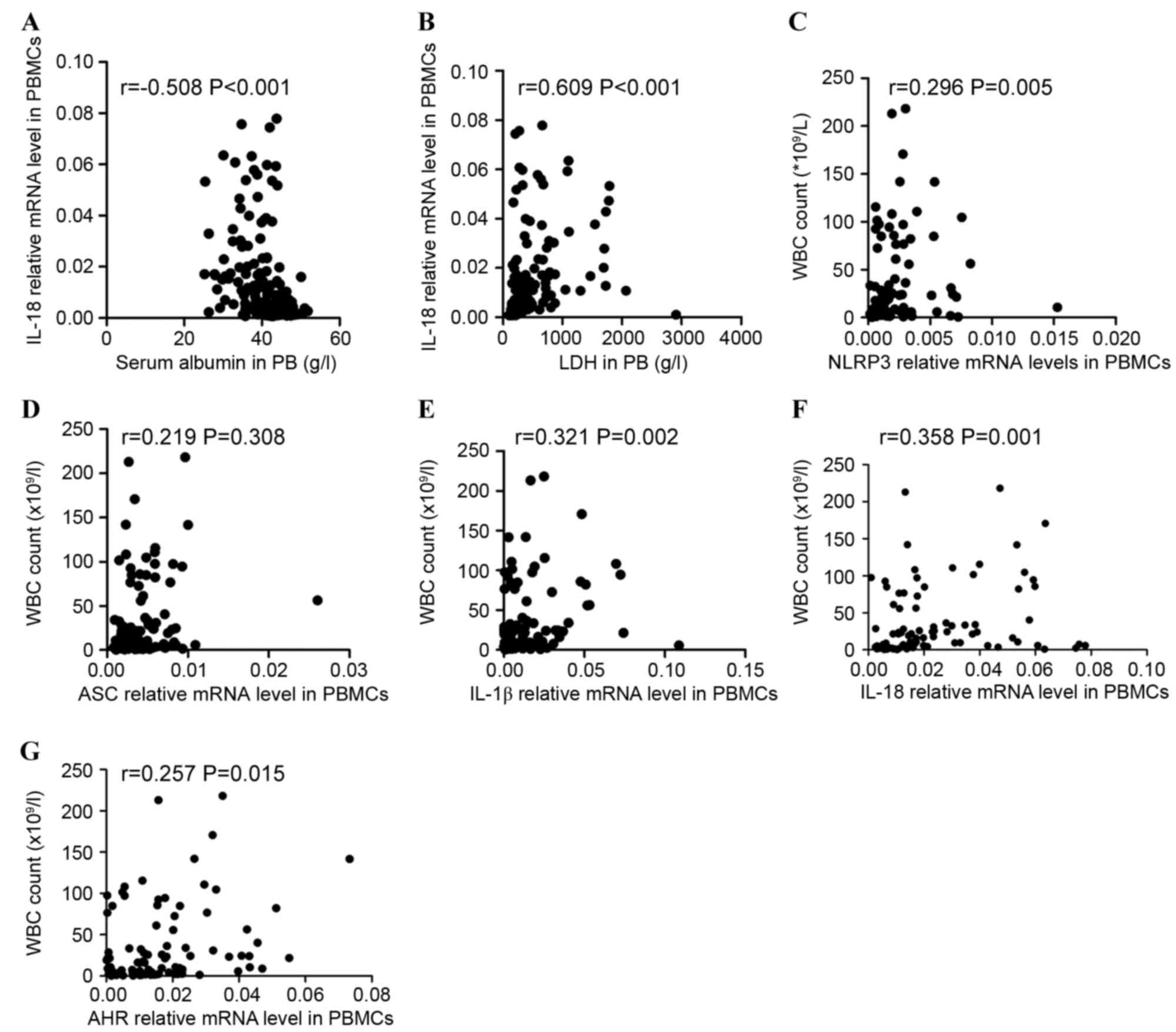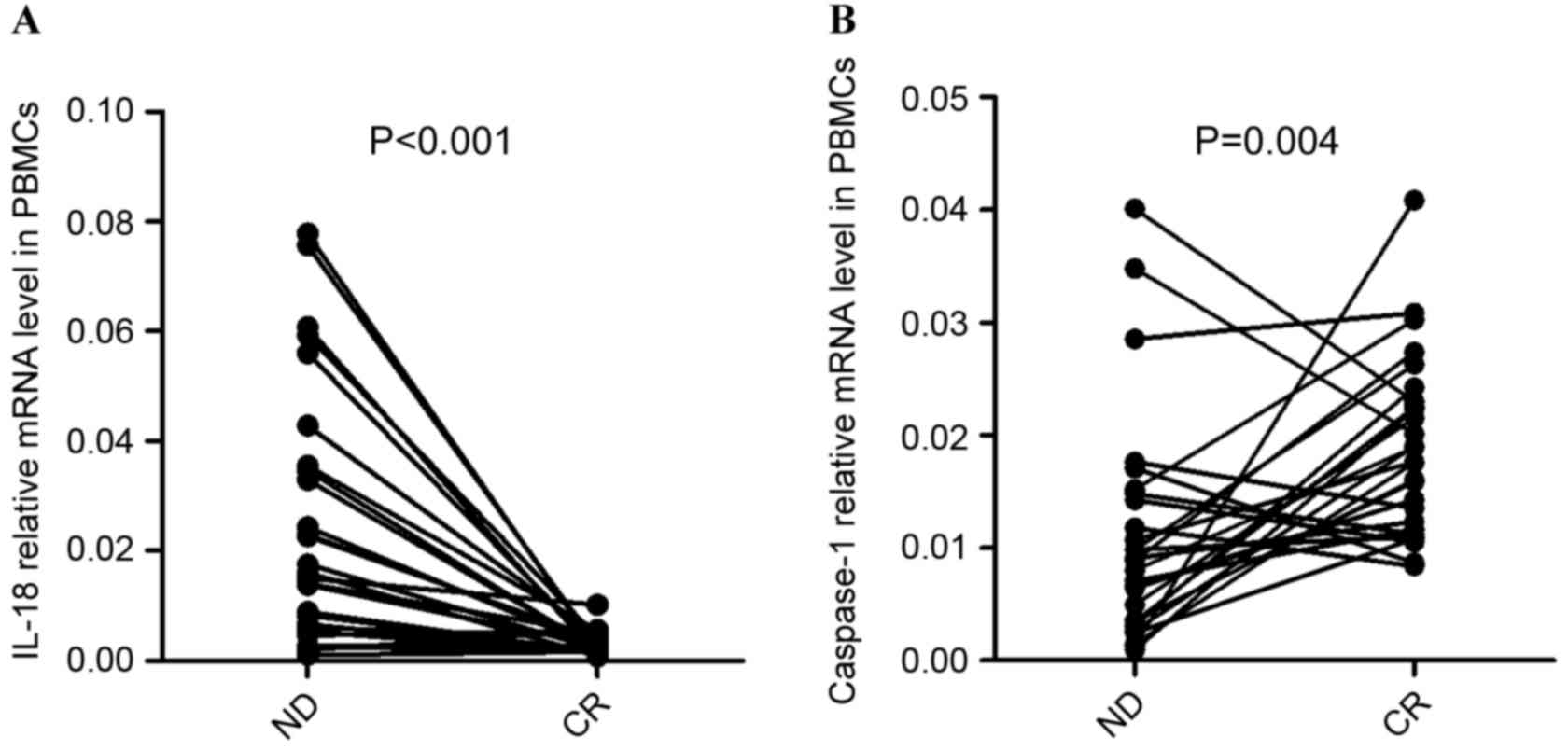|
1
|
Yu S, Liu C, Zhang L, Shan B, Tian T, Hu
Y, Shao L, Sun Y, Ji C and Ma D: Elevated Th22 cells correlated
with Th17 cells in peripheral blood of patients with acute myeloid
leukemia. Int J Mol Sci. 15:1927–1945. 2014. View Article : Google Scholar : PubMed/NCBI
|
|
2
|
Lucas CM, Wang L, Austin GM, Knight K,
Watmough SJ, Shwe KH, Dasgupta R, Butt NM, Galvani D, Hoyle CF, et
al: A population study of imatinib in chronic myeloid leukaemia
demonstrates lower efficacy than in clinical trials. Leukemia.
22:1963–1966. 2008. View Article : Google Scholar : PubMed/NCBI
|
|
3
|
Neill DR, Wong SH, Bellosi A, Flynn RJ,
Daly M, Langford TK, Bucks C, Kane CM, Fallon PG, Pannell R, et al:
Nuocytes represent a new innate effector leukocyte that mediates
type-2 immunity. Nature. 464:1367–1370. 2010. View Article : Google Scholar : PubMed/NCBI
|
|
4
|
Shao BZ, Xu ZQ, Han BZ, Su DF and Liu C:
NLRP3 inflammasome and its inhibitors: A review. Front Pharmacol.
6:2622015. View Article : Google Scholar : PubMed/NCBI
|
|
5
|
Sutterwala FS, Haasken S and Cassel SL:
Mechanism of NLRP3 inflammasome activation. Ann NY Acad Sci.
1319:82–95. 2014. View Article : Google Scholar : PubMed/NCBI
|
|
6
|
Bauernfeind FG, Horvath G, Stutz A,
Alnemri ES, MacDonald K, Speert D, Fernandes-Alnemri T, Wu J, Monks
BG, Fitzgerald KA, et al: Cutting edge: NF-kappaB activating
pattern recognition and cytokine receptors license NLRP3
inflammasome activation by regulating NLRP3 expression. J Immunol.
183:787–791. 2009. View Article : Google Scholar : PubMed/NCBI
|
|
7
|
Ozaki E, Campbell M and Doyle SL:
Targeting the NLRP3 inflammasome in chronic inflammatory diseases:
Current perspectives. J Inflamm Res. 8:15–27. 2015.PubMed/NCBI
|
|
8
|
Zhang N, Pan HF and Ye DQ: Th22 in
inflammatory and autoimmune disease: Prospects for therapeutic
intervention. Mol Cell Biochem. 353:41–46. 2011. View Article : Google Scholar : PubMed/NCBI
|
|
9
|
Cheng F, Guo Z, Xu H, Yan D and Li Q:
Decreased plasma IL22 levels, but not increased IL17 and IL23
levels, correlate with disease activity in patients with systemic
lupus erythematosus. Ann Rheum Dis. 68:604–606. 2009. View Article : Google Scholar : PubMed/NCBI
|
|
10
|
Nickoloff BJ: Cracking the cytokine code
in psoriasis. Nat Med. 13:242–244. 2007. View Article : Google Scholar : PubMed/NCBI
|
|
11
|
Brand S, Beigel F, Olszak T, Zitzmann K,
Eichhorst ST, Otte JM, Diepolder H, Marquardt A, Jagla W, Popp A,
et al: IL-22 is increased in active Crohn's disease and promotes
proinflammatory gene expression and intestinal epithelial cell
migration. Am J Physiol Gastrointest Liver Physiol. 290:G827–G838.
2006. View Article : Google Scholar : PubMed/NCBI
|
|
12
|
Shao LL, Zhang L, Hou Y, Yu S, Liu XG,
Huang XY, Sun YX, Tian T, He N, Ma DX, et al: Th22 cells as well as
Th17 cells expand differentially in patients with early-stage and
late-stage myelodysplastic syndrome. PLoS One. 7:e513392012.
View Article : Google Scholar : PubMed/NCBI
|
|
13
|
Hu Y, Li H, Zhang L, Shan B, Xu X, Li H,
Liu X, Xu S, Yu S, Ma D, et al: Elevated profiles of Th22 cells and
correlations with Th17 cells in patients with immune
thrombocytopenia. Hum Immunol. 73:629–635. 2012. View Article : Google Scholar : PubMed/NCBI
|
|
14
|
Tian T, Sun Y, Li M, He N, Yuan C, Yu S,
Wang M, Ji C and Ma D: Increased Th22 cells as well as Th17 cells
in patients with adult T-cell acute lymphoblastic leukemia. Clin
Chim Acta. 426:108–113. 2013. View Article : Google Scholar : PubMed/NCBI
|
|
15
|
Goergens A, Frericks M and Esser C: The
arylhydrocarbon receptor is only marginally involved in the
antileukemic effects of its ligand curcumin. Anticancer Res.
29:4657–4664. 2009.PubMed/NCBI
|
|
16
|
Zhu C, Xie Q and Zhao B: The role of AhR
in autoimmune regulation and its potential as a therapeutic target
against CD4 T cell mediated inflammatory disorder. Int J Mol Sci.
15:10116–10135. 2014. View Article : Google Scholar : PubMed/NCBI
|
|
17
|
Huai W, Zhao R, Song H, Zhao J, Zhang L,
Zhang L, Gao C, Han L and Zhao W: Aryl hydrocarbon receptor
negatively regulates NLRP3 inflammasome activity by inhibiting
NLRP3 transcription. Nat Commun. 5:47382014. View Article : Google Scholar : PubMed/NCBI
|
|
18
|
Gris D, Ye Z, Iocca HA, Wen H, Craven RR,
Gris P, Huang M, Schneider M, Miller SD and Ting JP: NLRP3 plays a
critical role in the development of experimental autoimmune
encephalomyelitis by mediating Th1 and Th17 responses. J Immunol.
185:974–981. 2010. View Article : Google Scholar : PubMed/NCBI
|
|
19
|
Cheson BD, Cassileth PA, Head DR, Schiffer
CA, Bennett JM, Bloomfield CD, Brunning R, Gale RP, Grever MR,
Keating MJ, et al: Report of the national cancer
institute-sponsored workshop on definitions of diagnosis and
response in acute myeloid leukemia. J Clin Oncol. 8:813–819. 1990.
View Article : Google Scholar : PubMed/NCBI
|
|
20
|
Vardiman JW: The Word Health Organization
(WHO) classification of tumors of the hematopoietic and lymphoid
tissues: An overview with emphasis on the myeloid neoplasms. Chem
Biol Interact. 184:16–20. 2010. View Article : Google Scholar : PubMed/NCBI
|
|
21
|
Livak KJ and Schmittgen TD: Analysis of
relative gene expression data using real-time quantitative PCR and
the 2(-Delta Delta C(T)) method. Methods. 25:402–408. 2001.
View Article : Google Scholar : PubMed/NCBI
|
|
22
|
Mathews RJ, Robinson JI, Battellino M,
Wong C and Taylor JC: Biologics in Rheumatoid Arthritis Genetics
and Genomics Study Syndicate (BRAGGSS), Eyre S, Churchman SM,
Wilson AG, Isaacs JD, et al: Evidence of NLRP3-inflammasome
activation in rheumatoid arthritis (RA); genetic variants within
the NLRP3-inflammasome complex in relation to susceptibility to RA
and response to anti-TNF treatment. Ann Rheum Dis. 73:1202–1210.
2014. View Article : Google Scholar : PubMed/NCBI
|
|
23
|
Satoh M, Tabuchi T, Itoh T and Nakamura M:
NLRP3 inflammasome activation in coronary artery disease: Results
from prospective and randomized study of treatment with
atorvastatin or rosuvastatin. Clin Sci (Lond). 126:233–241. 2014.
View Article : Google Scholar : PubMed/NCBI
|
|
24
|
Karki R, Man SM and Kanneganti TD:
Inflammasomes and cancer. Cancer Immunol Res. 5:94–99. 2017.
View Article : Google Scholar : PubMed/NCBI
|
|
25
|
Terlizzi M, Colarusso C, Popolo A, Pinto A
and Sorrentino R: IL-1α and IL-1β producing macrophages populate
lung tumor lesions in mice. Oncotarget. 7:58181–58192. 2016.
View Article : Google Scholar : PubMed/NCBI
|
|
26
|
Petrilli V: The multifaceted roles of
inflammasome proteins in cancer. Curr Opin Oncol. 29:35–40. 2017.
View Article : Google Scholar : PubMed/NCBI
|
|
27
|
Wei Q, Mu K, Li T, Zhang Y, Yang Z, Jia X,
Zhao W, Huai W, Guo P and Han L: Deregulation of the NLRP3
inflammasome in hepatic parenchymal cells during liver cancer
progression. Lab Invest. 94:52–62. 2014. View Article : Google Scholar : PubMed/NCBI
|
|
28
|
Terlizzi M, Casolaro V, Pinto A and
Sorrentino R: Inflammasome: Cancer's friend or foe? Pharmacol Ther.
143:24–33. 2014. View Article : Google Scholar : PubMed/NCBI
|
|
29
|
Busbee PB, Rouse M, Nagarkatti M and
Nagarkatti PS: Use of natural AhR ligands as potential therapeutic
modalities against inflammatory disorders. Nutr Rev. 71:353–369.
2013. View Article : Google Scholar : PubMed/NCBI
|
|
30
|
Negishi T, Kato Y, Ooneda O, Mimura J,
Takada T, Mochizuki H, Yamamoto M, Fujii-Kuriyama Y and Furusako S:
Effects of aryl hydrocarbon receptor signaling on the modulation of
TH1/TH2 balance. J Immunol. 175:7348–7356. 2005. View Article : Google Scholar : PubMed/NCBI
|
|
31
|
Arsenescu R, Arsenescu V, Zhong J, Nasser
M, Melinte R, Dingle RW, Swanson H and de Villiers WJ: Role of the
xenobiotic receptor in inflammatory bowel disease. Inflamm Bowel
Dis. 17:1149–1162. 2011. View Article : Google Scholar : PubMed/NCBI
|
|
32
|
Kobayashi S, Okamoto H, Iwamoto T, Toyama
Y, Tomatsu T, Yamanaka H and Momohara S: A role for the aryl
hydrocarbon receptor and the dioxin TCDD in rheumatoid arthritis.
Rheumatology (Oxford). 47:1317–1322. 2008. View Article : Google Scholar : PubMed/NCBI
|
|
33
|
Yang J, Yang X, Zou H, Chu Y and Li M:
Recovery of the immune balance between Th17 and regulatory T cells
as a treatment for systemic lupus erythematosus. Rheumatology
(Oxford). 50:1366–1372. 2011. View Article : Google Scholar : PubMed/NCBI
|
|
34
|
Hanieh H: Toward understanding the role of
aryl hydrocarbon receptor in the immune system: Current progress
and future trends. Biomed Res Int. 2014:5207632014. View Article : Google Scholar : PubMed/NCBI
|
|
35
|
Quintana FJ, Basso AS, Iglesias AH, Korn
T, Farez MF, Bettelli E, Caccamo M, Oukka M and Weiner HL: Control
of T(reg) and T(H)17 cell differentiation by the aryl hydrocarbon
receptor. Nature. 453:65–71. 2008. View Article : Google Scholar : PubMed/NCBI
|
|
36
|
Wing JB and Sakaguchi S: Foxp3+
T(reg) cells in humoral immunity. Int Immunol. 26:61–69. 2014.
View Article : Google Scholar : PubMed/NCBI
|
|
37
|
Nishikawa H and Sakaguchi S: Regulatory T
cells in cancer immunotherapy. Curr Opin Immunol. 27:1–7. 2014.
View Article : Google Scholar : PubMed/NCBI
|
|
38
|
Oertli M, Sundquist M, Hitzler I, Engler
DB, Arnold IC, Reuter S, Maxeiner J, Hansson M, Taube C,
Quiding-Järbrink M and Müller A: DC-derived IL-18 drives Treg
differentiation, murine Helicobacter pylori-specific immune
tolerance, and asthma protection. J Clin Invest. 122:1082–1096.
2012. View Article : Google Scholar : PubMed/NCBI
|
|
39
|
Peelen E, Damoiseaux J, Muris AH,
Knippenberg S, Smolders J, Hupperts R and Thewissen M: Increased
inflammasome related gene expression profile in PBMC may facilitate
T helper 17 cell induction in multiple sclerosis. Mol Immunol.
63:521–529. 2015. View Article : Google Scholar : PubMed/NCBI
|
|
40
|
Qin S, Ma S, Huang X, Lu D, Zhou Y and
Jiang H: Th22 cells are associated with hepatocellular carcinoma
development and progression. Chin J Cancer Res. 26:135–141.
2014.PubMed/NCBI
|
|
41
|
Zhang W, Tian X, Mumtahana F, Jiao J,
Zhang T, Croce KD, Ma D, Kong B and Cui B: The existence of Th22,
pure Th17 and Th1 cells in CIN and cervical cancer along with their
frequency variation in different stages of cervical cancer. BMC
Cancer. 15:7172015. View Article : Google Scholar : PubMed/NCBI
|



